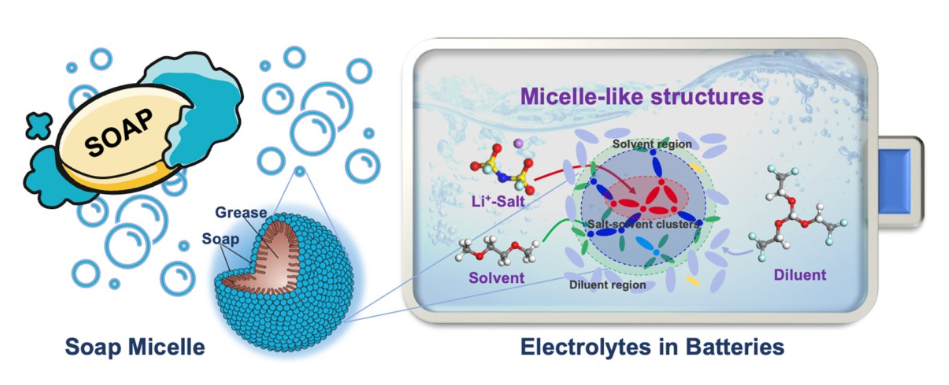Scientists discovered that a highly promising electrolyte for creating lithium batteries with extended lifespan exhibits intricate nanostructures that function similarly to micelle structures in soapy water.
 Researchers show that one of the most promising substances for designing longer lasting lithium batteries form micelle-like structures like they do in soap. Image Credit: Yue Qi
Researchers show that one of the most promising substances for designing longer lasting lithium batteries form micelle-like structures like they do in soap. Image Credit: Yue Qi
In the pursuit of creating longer-lasting batteries, a team of researchers, including engineers from Brown University and Idaho National Laboratory, suggests that the key lies in the principles of cleaning—specifically, the way soap operates in this context.
Consider handwashing as an analogy. When soap is used, it forms structures known as micelles, which trap and remove grease, dirt, and germs when rinsed with water. This happens because the soap acts as a bridge between the water and the substances to be cleaned, binding them and encasing them in these micelle structures.
In a recent study published in Nature Materials, researchers observed a similar process at play in one of the most promising materials for designing longer-lasting lithium batteries—a new type of electrolyte called a localized high-concentration electrolyte. The newfound understanding of this mechanism, as proposed in the paper, could be the crucial element needed to significantly advance this emerging sector of technology.
The big picture is that we want to improve and increase the energy density for batteries, meaning how much energy they store per cycle and how many cycles the battery lasts. To do this, materials inside of traditional batteries need to be replaced to make long-life batteries that store more energy a reality - think batteries that can power a phone for a week or more, or electric vehicles that go for 500 miles.
Yue Qi, Professor, School of Engineering, Brown University
Researchers are actively pursuing the transition to batteries incorporating lithium metal due to their significantly higher energy storage capacity compared to current lithium-ion batteries. However, the challenge lies in traditional electrolytes, crucial for enabling an electrical charge to move between a battery's terminals and initiating the necessary electrochemical reaction for converting stored chemical energy into electric energy. Traditional electrolytes designed for lithium-ion batteries, primarily composed of low-concentration salt dissolved in a liquid solvent, are not as effective in metal-based batteries.
In response to this challenge, scientists at Idaho National Laboratory and Pacific Northwest National Laboratory have developed localized high-concentration electrolytes. These electrolytes are created by blending high concentrations of salt in solvent with another liquid called a diluent. The addition of the diluent enhances the flow of the electrolyte, ensuring the battery's power can be effectively maintained.
While lab tests have demonstrated promising results for this innovative electrolyte, a comprehensive understanding of how it functions and why has been lacking. This knowledge gap has limited its effectiveness and hindered further development. The new study aims to bridge this gap, shedding light on the mechanisms behind its operation and paving the way for more effective and refined advancements.
The paper provides a unified theory as to why this electrolyte works better and the key understanding of it came by finding that micelle-like structures form within this electrolyte like they do with soap. Here we see that the role of the soap or surfactant is played by the solvent that binds both the diluent and the salt, wrapping itself around the higher concentration salt in the center of the micelle.
Bin Li, Senior Scientist, Oak Ridge National Laboratory
By gaining a deeper understanding of the underlying mechanisms, the researchers successfully deciphered the optimal ratios and concentrations necessary to induce optimal reactions in the batteries.
This breakthrough addresses a significant engineering challenge in formulating this electrolyte, specifically in striking the right balance for the three key ingredients. The research not only provides improved guidelines for creating functional localized high-concentration electrolytes but also paves the way for even more effective designs.
Researchers at Idaho National Laboratory put this theory into practice and found that, so far, the theory holds up and contributes to extending the lifespan of lithium metal batteries. While the team is eager to see the potential designs for localized high-concentration electrolytes stemming from their work, they acknowledge that substantial progress is still needed to overcome the bottleneck in electrolyte design for high-density batteries. Interestingly, they find it amusing that the solution may have been found in something as ordinary and everyday as soap.
The concept of the micelle may be new for the electrolyte, but it’s actually very common for our daily life. Now we have a theory, and we have guidelines to get interactions we want from the salt, the solvent and the diluent in the electrolyte, and what concentration they have to be at and how you mix them.
Yue Qi, Professor, School of Engineering, Brown University
The research was headed by Corey M. Efaw at Idaho National Laboratory and Qisheng Wu, a Senior Research Associate at Brown’s School of Engineering. Other collaborators included scientists from Boise State University, Brookhaven National Laboratory and University of Washington. The theoretical work at Brown was financially supported by NASA, and the experimental work was supported by the US Department of Energy Battery500 Consortium.
Journal Reference:
Efaw, M, C., et al. (2023). Localized high-concentration electrolytes get more localized through micelle-like structures. Nature Materials. doi.org/10.1038/s41563-023-01700-3